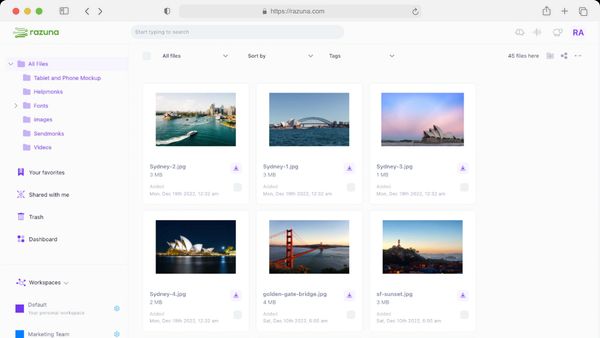
Announcing Collect+: Save and share everything
COLLECT+ is a productivity tool that helps you save and share everything you find on the web. It is built into the Razuna digital asset management platform.
Read nowVideo sharing online involves uploading and sharing videos over social media platforms and the internet. Everyone, from social media influencers to digital marketing teams, does this. But how do they share their large video files without overloading their web servers?
This is where dedicated video-sharing platforms play an essential role. Video-hosting sites are usually the best way to share your video files and offer several key benefits. However, numerous other options exist for sharing all of those large video files.
Discover what they are in this in-depth guide to the seven best video-sharing methods for 2024.
A large video file has a high megabyte/gigabyte (MB/GB) size. The higher the resolution and the longer the footage, the bigger the video file. But how large is ‘large'? This may differ from one platform to the next. For example, email providers limit the size of files sent via their servers.
Gmail lets you add attachments like photos and video clips to your emails. However, they limit the video file attachments to 25MB. If you have multiple attachments, they can't total more than 25MB. In cases where the video file is larger than this, Gmail automatically adds a Google Drive link to use instead.
Even social media video uploads are subject to limitations, for example, 256GB per 12 hours on YouTube. By default, you can upload videos up to 15 minutes in length. Verified accounts can upload videos that are longer than this.
Video-sharing platforms are online services that allow users to store, manage, share, and collaborate on video content. These platforms can be public–where you can share your videos with the world–or private to your organization or team.
Different video-sharing platforms serve different purposes, including social sharing, public distribution, and internal collaboration within companies.
These platforms offer features such as file storage, sharing, and collaboration tools, allowing users to seamlessly upload, organize, and share their digital content.
These are the top three benefits of video-sharing platforms for your business.
Does your team need to collaborate on your brand's digital marketing content regularly? Enhanced, efficient collaboration is a major benefit of using video-sharing platforms. Team members will work together seamlessly, independent of geographic and time zone restrictions.
Video sharing allows them to collaborate on marketing video projects, comment on each collaborator's work, and give valuable feedback. You can also use video-sharing platforms to review, revise, edit, and approve these videos.
Is the security of your video content a concern for you? Video-sharing platforms offer the peace of mind that comes with having centralized, secure storage.
When transferring your video files over the network or the internet, your data can be encrypted. This encryption applies to data stored on your devices and in the cloud. Unauthorized access won't be a problem if your video-sharing platform allows advanced access control methods.
There are many steps on the road to producing top-ranking digital content, meaning there will be many edits and revisions. Fortunately, the top video-sharing platforms offer version control and other file management aspects.
Version control allows you to keep track of every change made to your marketing video files every step of the way. Your team will also still have access to the original, unedited format. Need to go back to the drawing board? Just access the original version!
Video-sharing platforms are the best way to share large video files. This can streamline your content creation and marketing processes. However, there are seven easy ways to share large video files, and your team's specific needs will determine your choices.
Whether you need to share a large video file for content collaboration, final review, or publication, you'll find a solution in the list below.
Using a cloud storage service will keep your digital data safe and secure, no matter where you and your team are located in the world.
You'll avoid the risk of data loss due to cyberattacks and technical malfunction. But you can still access and share your large video files from the cloud, subject to the access and sharing permissions you set.
Below are four of the best cloud storage services you can use to share large videos:
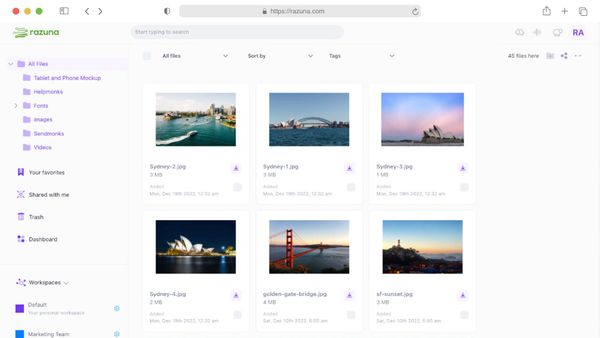
Razuna is a top cloud-based digital asset management (DAM) service for managing, storing, and sharing all your digital content, including large video files. Razuna's multi-functionality is what makes it the ideal platform for video sharing.
Users can create a free account in seconds, with 500GB of storage included. The platform fulfills many needs in the business environment and is particularly beneficial to marketing teams. You can store, edit, review, share, and collaborate on digital content with just a few clicks.
Create one or multiple shared links to share your large video files publicly. Each link will have individual settings. Your large video files will be accessible from any device, too.
But it doesn't stop at video sharing and storage. As part of the Helpmonks stack, your Razuna account offers access to top-quality email management, marketing, and customer engagement tools.
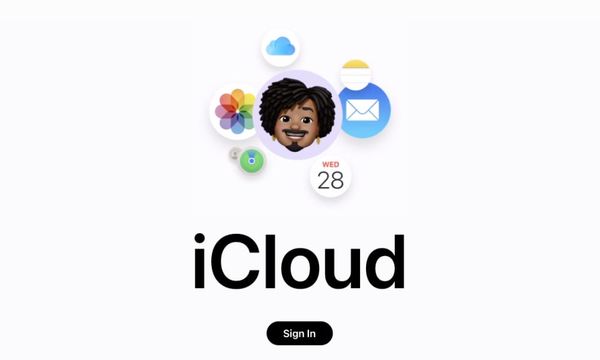
iCloud is a cloud storage and cloud computing service from Apple Inc. This platform can store and sync data across devices like iPhones, iPads, Macs, and Windows PCs. Any changes you make to content in iCloud will sync to your other Apple devices.
iCloud includes a free email account and 5GB of free storage for your data, but more storage is available with an upgrade to iCloud +.

Dropbox is a cloud-based file storage service that allows users to back up and sync files and share large document folders and video files. There's a free plan with 2GB of storage, but paid plans offer higher storage and additional features.
You'll need to sign up for an account and download the app to use Dropbox. Then, you can share video files with your team directly from your cloud storage. Dropbox allows users to share up to 100GB, but you can upgrade this to 250GB with Dropbox Transfer.
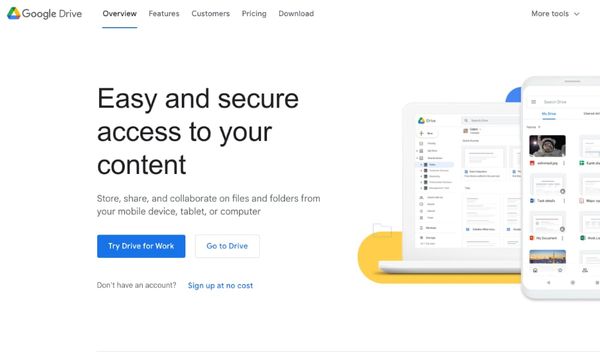
Google Drive is Google's file storage and synchronization service. It lets you upload, sync, and share your files online, including large video files. Google Drive integrates with other Google products like Gmail, Google Docs, and Google Sheets.
Like all other cloud services, it uploads your large video files to its remote servers in the Cloud. This is how Google Drive reduces the load on your hard drive and frees up space on your devices.
But the biggest benefit of using a cloud-based service like Google Drive is that your team can access those files from any device connected to the internet. This facilitates online collaboration on your marketing video content.
If you have a Google account, it'll include a Gmail account and Google Drive, with 15GB of storage on the free plan. Paid plans offer much higher storage capabilities, up to a maximum of 2TB.
Large video files can strain your system resources, using huge bandwidth and slowing computers down.
Compressing your large video files addresses both issues and makes video sharing much easier. It can make your videos more accessible to your intended audience, too.
When you share videos for marketing purposes, viewers may access them on smartphones using cellular data or older PCs with slower Wi-Fi. Compressing video files will make it easier for them to play and watch your content and share it with friends.
A video-hosting site provides the ideal platform for sharing your video content. They often have limitations on file size and number of daily uploads. Your video content will also be subject to specific criteria.
Despite these restrictions, you'll enjoy a wider audience with the potential for massive growth. YouTube and DailyMotion are the two largest video-hosting sites in the world. So, to widen your customer base, consider using one or both of these platforms.
That said, each platform has distinct advantages.
YouTube has a wide audience and is better for organic search traffic with higher advertisement engagement. You can monetize your content but need a high number of subscribers. Despite a smaller number of subscribers, DailyMotion is your go-to for monetization.
Almost 2.7 billion people worldwide use YouTube regularly. As the world's population of online users grows, YouTube's popularity will grow. More than 500 hours of content are uploaded to this platform every minute.
Because of its extensive reach, it's a powerful marketing tool for all types of businesses.
Sharing large video files on YouTube is quick and easy. You'll need a YouTube account, but you can create it for free. You'll be allowed to upload videos up to 15 minutes long automatically. To upload longer video files, your account will need to be verified.
You can edit the video's title, description, tags, and thumbnail while still uploading. Once it's been uploaded, there will be a link you can copy to share it wherever and whenever you want. Alternatively, use the ‘share' button to send the link via email or social media.
There are options for privacy, too. This allows you to set your video for public or private viewing.
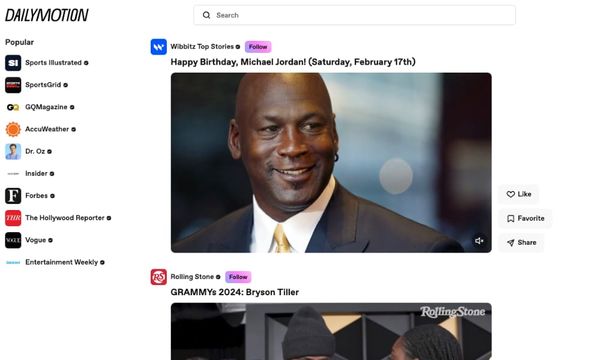
DailyMotion is a French-hosted video-sharing website with a reach that is a close competitor to YouTube. Users are allowed to upload, share, and view content. In French-speaking countries, the unit of file size used is the Go. A Go equates to a GB, which in binary equates to 1,024 MB. Therefore, a binary definition of the Go is 1GB or 1,024 MB.
This is important because DailyMotion's upload policies are expressed using Go.
The current DailyMotion upload policy states that new accounts may upload video files with a maximum size of 4 Go and a maximum duration of 2 hours. Users may upload 15 video files of this size and duration per day, i.e., 10 hours of content.
Other specifications for the format, video codec, framerate, bitrate, and resolution may apply. The advanced user option allows uploads of 96 videos, a maximum of 64 Go, daily. There is no cap on the duration.
A USB flash drive gives you the power of video sharing on the go.
This is still one of the simplest ways to store and access large video files. It's small, portable, and lets you take your video files wherever you go. You can work from home or anywhere while editing your large video files. Simply insert the flash drive into your other devices.
5. Send Your Video With Email
Email is the primary communication method in the business environment. It also remains a top method for marketing. And one of the best things about email is that it offers the opportunity to attach other files.
You can add images, graphics, and even video files for collaboration and distribution in email marketing campaigns. However, as noted earlier in this article, there will sometimes be limitations on the file size you can send as an attachment in the email.
Here are the top two email-hosting sites you can use to send large video files:
Gmail is Google's email service and is one of the most popular email platforms worldwide. It offers a huge storage capacity of 15GB for free. More storage is available through a paid subscription to Google One.
Gmail works with other Google products like Google Docs, Google Meet, and Google Drive. It also allows attachments like photos and video files. Just link your Gmail to your Google Drive account, upload your video files to Google Drive, and share them through Gmail.
When composing an email, you can share video files up to 25MB using the ‘attachment' feature. For uploads above this size, you must select the option ‘Insert Files Using Drive'.
Outlook is a productivity tool in the Microsoft 365 products suite. Microsoft customers can use it to access their emails, manage their calendar appointments, and share photo or video files. This is all possible in one place, with a free account available.
When you use Outlook to share large video files, the type of email account you have will determine the best approach.
You can upload your file to a cloud service and share a link in your email. You can also reduce the size by compressing or zipping it or before attaching it to your email. Outlook also offers a resizing feature to resize content automatically.
Alternatively, save your large video file to a SharePoint library and share a link to the file with your team in an email message.
Sharing video files via mobile is efficient in today's fast-paced business world. Whether for remote collaboration, on-the-go access to important files, mobile learning, or client presentations, mobile sharing offers flexible and instantaneous sharing of files.
Here are the top two methods to share videos via your iPhone:
Do you want to wirelessly send large video files (or photos and documents) to your collaborators' nearby iPhone devices and Mac computers from an iPhone? AirDrop is the solution.
Transfers are encrypted for extra security. As a bonus, any AirDrop file transfers in progress will continue over the internet if you have to leave Bluetooth or Wi-Fi range mid-way through.
Are you an iPhone user frustrated by email limitations for video file sharing? Maildrop may be the answer. It's a program on iPhones, Macs, and iPads that you can use to send large email attachments over iCloud.
This helps bypass those annoying email size limits for large video file sharing. However, Maildrop also has limitations, and a message with attachments should not be larger than 5GB.
Despite the iPhone's popularity, especially in the corporate environment, the vast majority of the world's smartphones run Android. Here's the best method to share videos via your Android:

With Google Photos, you can edit, store, share, and view photos and video files. Your files are automatically backed up. This cloud-based software is easily backed onto your computer or external hard drive. Google Photos can be used on both Android and iOS devices.
The app provides unlimited free storage if you save your media as high-quality images. Large video files are usually compressed to save space, but you can change this in your account's settings.
There are many ways to share large video files. Each has unique benefits, and you'll probably need to use most, if not all, of them at some point. But is there one of the best that outshines the rest? Yes, there is, and it offers the practicality, versatility, and convenience every business needs.
When you choose Razuna for your large video-sharing requirements, you'll enjoy all the benefits of streamlined and efficient digital asset management. This, in turn, enhances your content collaboration and marketing processes. All on one user-friendly platform.
Get started today by registering your free Razuna account!

COLLECT+ is a productivity tool that helps you save and share everything you find on the web. It is built into the Razuna digital asset management platform.
Read now
These 18 tips for efficient photo organization are the best strategies for every marketer. Learn how to keep your digital images organized and accessible.
Read now
A digital asset library software organizes all digital assets in one place. But which one is the best? Here are the top 8 asset library software choices.
Read now
The latest update to our Digital Asset Management system, is focused on giving more power and flexibility to control user permissions, file, and folder access.
Read now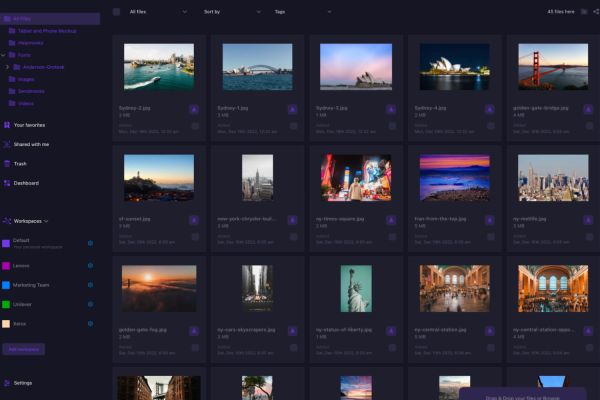
(each free accounts comes with 500 GB space)
